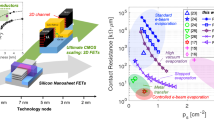Abstract
The effect of p-well contact on the n-well potential modulation in a 90 nm bulk technology with P+ deep well is studied based on three-dimensional (3-D) TCAD device simulations. Simulation results illustrate that the p-well contact area has a great impact on the n-well potential modulation and the enhancement factor will level out as the p-well contact area increases, and that at the same time the increase of p-well doping concentration can also enhance the n-well potential modulation. However, the effect of p-well contact location on the n-well modulation is not obvious as the p-well contact distance increases. According to our simulation results, it is proposed that the p-well contact area should be cautiously designed to mitigate single event effect (SEE) in the P+ deep well technology.
Similar content being viewed by others
References
Gapspard N J. Impact of well structure on SE response in 90-nm bulk CMOS. Master Thesis. Nashville: Vanderbilt University, 2011
Amusan O A, Witulski A F, Massengill L W, et al. Charge collection and charge sharing in a 130 nm CMOS technology. IEEE Trans Nucl Sci, 2006, 53(6): 3253–3258
Olson B D, Amusan O A, Dasgupta S, et al. Analysis of parasitic pnp bipolar transistor mitigation using well contacts in 130 nm and 90 nm CMOS Technology. IEEE Trans Nucl Sci, 2007, 54(4): 894–897
DasGupta S, Witulski A F, Bhuva B L, et al. Effect of well and substrate potential modulation on single event pulse shape in deep submicron CMOS. IEEE Trans Nucl Sci, 2007, 54(6): 2407–2412
Amusan O A, Massengill L W, Baze M P, et al. Mitigation techniques for single-event-induced charge sharing in a 90-nm bulk CMOS process. IEEE Trans Nucl Sci, 2009, 9(2): 311–316
Qin J R, Chen S M, Liu B W, et al. Research on single event transient pulse quenching effect in 90 nm CMOS technology. Sci China Ser E-Tech Sci, 2011, 54(11): 3064–3069
Olson B D, Ball D R, Warren K M, et al. Simultaneous single event charge sharing and parasitic bipolar conduction in a highly-scaled SRAM design. IEEE Trans Nucl Sci, 2005, 52(6): 2132–2136
Amusan O A, Casey M C, Bhuva B L, et al. Laser verification of charge sharing in a 90 nm bulk CMOS process. IEEE Trans Nucl Sci, 2009, 56(6): 3065–3070
Amusan O A, Massengill L W, Baze M P, et al. Single event upsets in deep-submicrometer technologies due to charge sharing. IEEE Trans Nucl Sci, 2008, 8(3): 582–589
Amusan O A, Massengill L W, Bhuva B L, et al. Design techniques to reduce set pulse widths in deep-submicron combinational logic. IEEE Trans Nucl Sci, 2007, 54(6): 2060–2064
Brown D, Ghezzo M, Pimbley J, et al. Trends in advanced process technology-Submicrometer CMOS device design and process requirements. Proc of the IEEE, 1986, 74(12): 1678–1702
Author information
Authors and Affiliations
Corresponding author
Rights and permissions
About this article
Cite this article
Du, Y., Chen, S., Liu, B. et al. Effect of p-well contact on n-well potential modulation in a 90 nm bulk technology. Sci. China Technol. Sci. 55, 1001–1006 (2012). https://doi.org/10.1007/s11431-011-4704-6
Received:
Accepted:
Published:
Issue Date:
DOI: https://doi.org/10.1007/s11431-011-4704-6




